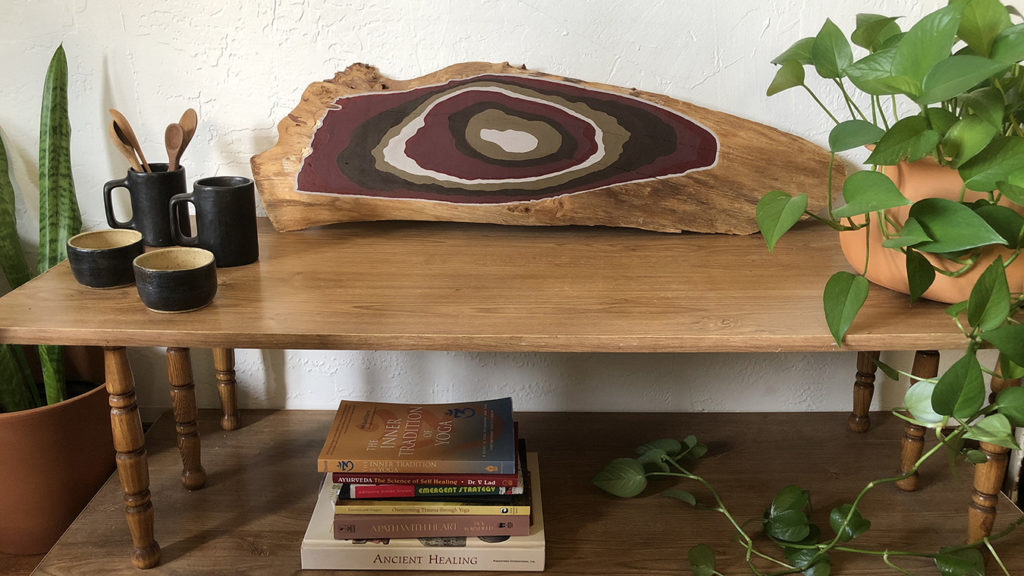Jenna Green’s goal is to integrate art, meditation, and movement into museum programs and other community art spaces.
“That can be mindfulness, meditation, beholding or slow looking at art,” said Green, a PhD student in art history and art education at the University of Arizona School of Art.
“I’ve also done in the meditation realm, color guided meditations and contemplatively or mindfully making color collages and color poems. Tapping into some of those other senses and in a more slow and intentional way create your own personal connection to a color or to a work of art.”
Green, a University Fellow, was worked on multiple projects involving arts and wellbeing. From awe-walking to research projects, she has combined her two interests, health and the arts.

Arts and Wellbeing
“I think that one of the greatest aspects of being a human is that we get to create, reimagine, and engage with the world around us,” Green said.
She is interested in programs and events that extend beyond art history and tap into people’s personal lives, personalities, and engage in social, emotional, and mental wellbeing.
“I think especially from the pandemic where we kinda had to shut things down and be isolated, we were reminded that we are interconnected and that there are multiple facets to our wellbeing and it’s important to give each of those facets time, attention, and care,” she added.
She said the gratifying part about her job is to see people emotionally respond to art or feel welcomed and belonged in a museum space.
Her Academic Journey
Green had many different threads that she would later pull and combine to make a career and lifestyle. Growing up in Phoenix, her mother was a nurse and her grandmothers incorporated art into their everyday life.
During her last semester of her undergraduate studies, she took history and art history classes in Barcelona, Spain.
“I just really fell in love with the museums,” she said. “I wasn’t able to understand the labels … but there was something else that really just sparked like a little fire in me.”
Green earned her bachelor’s degree in global health and anthropology at Arizona State University.
“I really started to look at and observe how different cultures, past and present, view health or view wellness whether tied to folklore or mythology or just their societal practices,” she said.

Next, Green received her master’s degree from the University of Washington in museum studies, with an emphasis in education and evaluation. She wrote her thesis on how three different museums integrated art therapy programs in their spaces.
“I was really interested in the way that health professionals partner with and work in museums to help either their clients or the larger community that they are situated in,” Green said.
During the pandemic, Green decided to go back for her PhD. She said she wanted to dig a little deeper in honing her craft in teaching, her views with teaching and art, and develop more of a relationship with art making and looking.
She selected the University of Arizona because of the school’s focus on museums and the types of faculty research.
Green is currently collaborating on a research study with Dr. Carissa DiCindio. The study uses art making and reflection to investigate the local community’s relationship to Tucson’s ecology and to climate futures, she said.
Dr. DiCindio and Green presented their research project last week at the Art Education Research Institute’s National Symposium, hosted by the School of Art’s Art & Visual Culture Education. This week the pair presented a Gallery Talk about the project, “The Nature of Change, ” at the “Ways of Knowing, Ways of Being: Arts Research and Integration” exhibition at the Center for Creative Photography.
Personal Journey
While on her educational path, Green started to look inward and find activities that made her feel grounded. During her first round of grad school, Green said that’s when she started practicing yoga.
“Grad school is always about what’s in your head, but like I needed that connection to my physicalness and so those yoga classes were a good way for me to connect back to myself,” she continued.
Green wanted to learn more and registered for her yoga teacher training classes right before the pandemic hit. She earned her first 200 hours online.

Settling In
Green moved into her graduate studio and has been settling into the space. She said she has started to work on painting again and hopes to start facilitating yoga classes.
She used to teach a virtual series of yoga classes for the National Emerging Museum Professional Network, where she included reflective journaling, writing, discussion with yoga asana movements, and breath work.
“I think that’s part of my teaching philosophy in integrating contemplative arts and contemplative practices is to teach from a place of knowing and so in that I am trying to develop my own mindfulness and meditation practice, or like daily contemplative art practice”
After grad school, Green said she wants to live in another part of the world as well as finding a fellowship or research apprenticeship at a museum or university abroad and to continue her research on integrating arts health in a museum setting.
“I think art can be,and is in many ways, one of the best ways to tap into those multiple dimensions of health and wellbeing,” Green said. “I think the beautiful thing about art is that you don’t need to have those technical skills in order to express yourself in order to be creative. Anything can be an expression of what you’re thinking or what you’re feeling and the arts are so malleable.”
